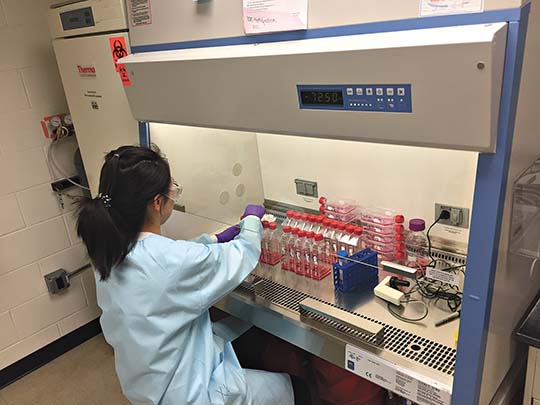MTU professor works to improve future of vaccine purification

Photo provided by the Heldt Lab Dr. Xue Mi works at the biosafety cabinet growing cells and viruses.
HOUGHTON — A Michigan Technological University professor is working on improvements to the vaccine purification process that could, within a decade, make it easier to ramp up production of future vaccines.
The current process for vaccines, including those being developed for COVID-19, starts with growing samples of the virus inside a bioreactor. The next step is purifying the sample to remove extraneous material. That process — getting the virus from 0.1% of the material to 99.9% — can be difficult, said Caryn Heldt, director of the Michigan Tech Health Research Institute and the James and Lorna Mack Chair in Bioengineering.
The vaccines are tested after each step of purification, and the vaccine is also required to be stable at each stage.
“What our work is, we’re trying to take this batch process and make it a continuous process,” Heldt said.
There are two major hurdles, Heldt said. They have to be continuously able to make the vaccine. And they need to be able to have online centers so they do not have to stop and wait for a quality control lab to do testing.
One method being worked on is an aqueous two-phase extraction technique. She adds polymer and a salt to water, which she compares to separating out oil and water. The contaminating proteins stay in the salt phase, leaving the virus.
“They separate, because thermodynamically, they don’t want to be together,” Heldt said.
There is also filtration, a continuous operation in which viral material is pulled into a vacuum on the other side of the cell membrane.
The continual methods have several advantages, Heldt said. It would be significantly faster. And with a smaller plant required, it would cost less to build, require less labor to run and have a smaller environmental footprint.
It also eliminates one of the largest costs: cleaning between the batches of vaccine.
“When you’re continuously running, you’re cleaning your equipment less often,” she said.
To save in cleaning costs and to save water, many manufacturers are moving from stainless steel bioreactors to plastic bags. Counterintuitively, the single-use bags are better for the environment, Heldt said. The stainless steel requires more energy, cleaning materials and water.
“In most places in the world, water is a very, very valuable commodity,” she said. “If you have to heat it up, sterilize things, that takes a lot of energy.”
Heldt’s lab is working with researchers at Johns Hopkins and Mount Sinai Hospital on improvements for production of flu vaccines, allowing them to easily swap in new strains of the virus.
It will probably take five to 10 years before the new purification methods would be used for a vaccine, Heldt said. When the FDA approves a vaccine, the process is part of it.
“Nobody wants to go through clinical trials to be able to change their manufacturing process,” she said. “It would only affect future vaccines and not the ones that are currently on the market.”





